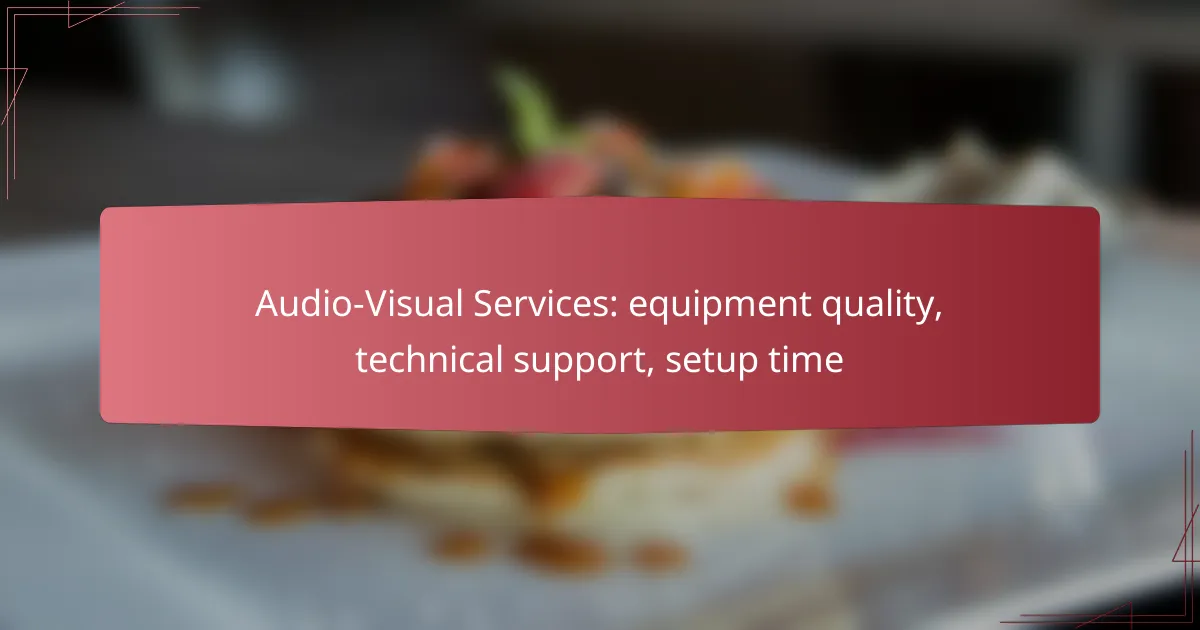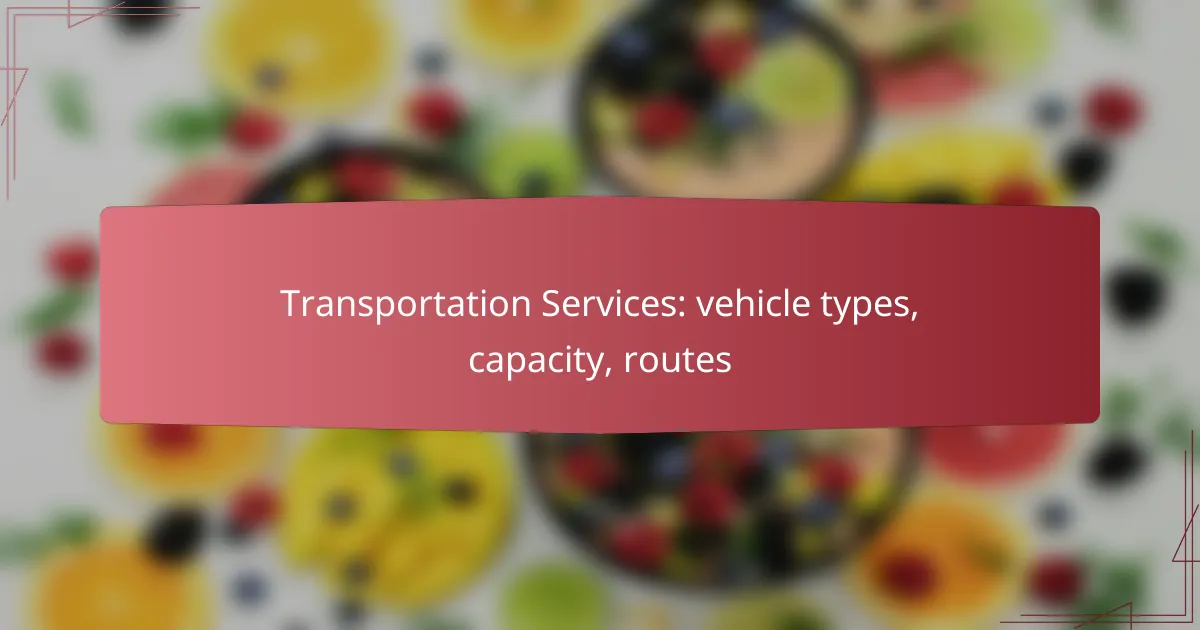When it comes to audio-visual services, the combination of high-quality equipment, dependable technical support, and swift setup times is crucial for a successful event. Quality equipment guarantees clear sound and vibrant visuals, enhancing audience engagement and communication. Additionally, robust technical support ensures that any issues are promptly addressed, allowing events to run smoothly and efficiently.
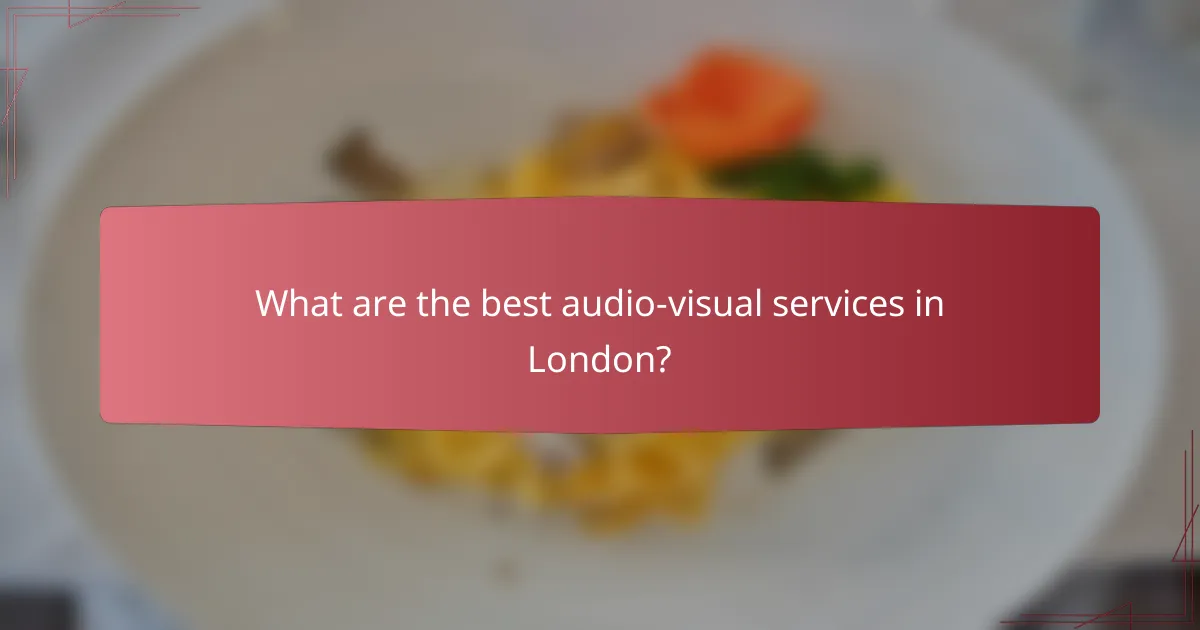
What are the best audio-visual services in London?
The best audio-visual services in London are characterized by high-quality equipment, reliable technical support, and efficient setup times. These services cater to a range of events, ensuring that clients receive tailored solutions that meet their specific needs.
Top-rated local providers
Some of the top-rated audio-visual service providers in London include companies like AV Events, Sound & Vision, and Event AV. These providers are known for their extensive inventory of high-end equipment and experienced technicians who can handle various event types, from corporate meetings to large-scale concerts.
When selecting a provider, consider their reputation, customer reviews, and the range of services offered. It’s beneficial to choose a company that has experience with your specific type of event to ensure they can meet your technical requirements effectively.
Service offerings comparison
Audio-visual services typically include equipment rental, setup, and on-site technical support. Providers may offer packages that combine these services, which can be more cost-effective than purchasing them separately. For example, a basic package might include projectors, screens, and sound systems, while premium options could feature advanced lighting and video conferencing tools.
When comparing services, look for details such as setup time, availability of support staff during the event, and the quality of equipment. It’s advisable to request quotes from multiple providers to find the best balance of quality and price, keeping in mind that rates can vary significantly based on the equipment and services included.
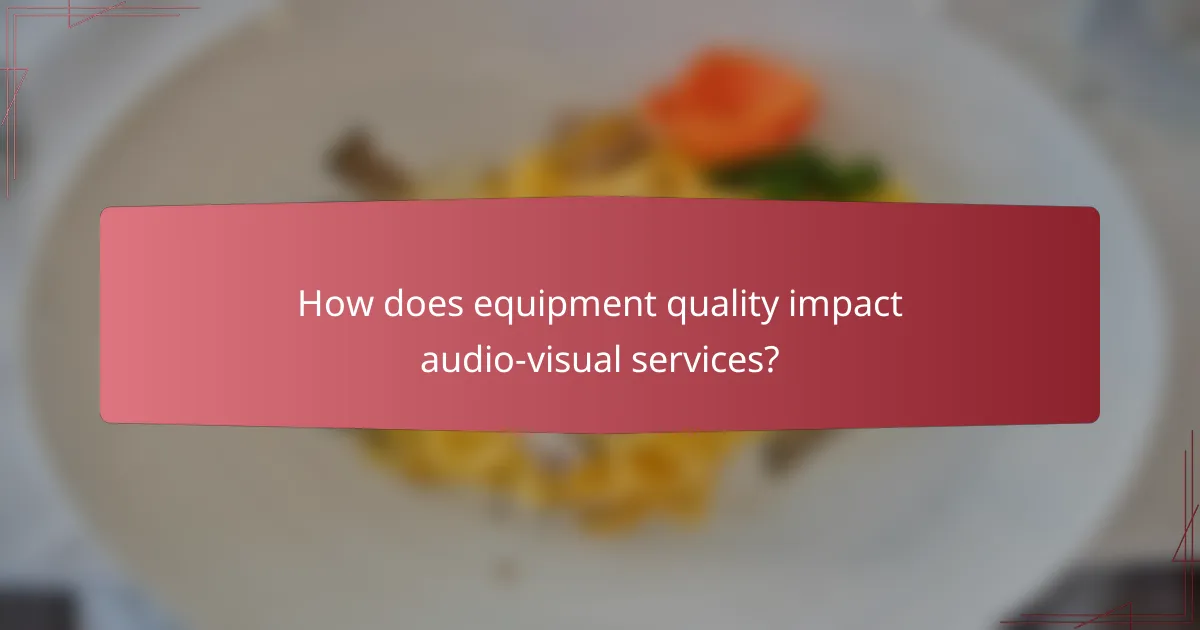
How does equipment quality impact audio-visual services?
Equipment quality significantly affects the performance and reliability of audio-visual services. High-quality equipment ensures clear sound and sharp visuals, which are essential for effective communication and audience engagement.
Importance of high-quality equipment
High-quality equipment is crucial for delivering professional audio-visual services. It minimizes technical issues, enhances user experience, and reflects positively on the event or presentation. Investing in superior gear can lead to better sound fidelity, image clarity, and overall production value.
When selecting audio-visual equipment, consider factors such as durability, compatibility, and performance specifications. For instance, using high-definition projectors and professional-grade microphones can significantly improve audience engagement and retention.
Recommended brands for AV equipment
Several brands are recognized for their reliable audio-visual equipment. Companies like Sony, Shure, and Bose are known for their high-quality audio solutions, while Epson and Panasonic excel in visual technology. These brands often meet industry standards and are widely used in professional settings.
When choosing equipment, look for brands that offer warranties and customer support. This can be crucial for troubleshooting and maintenance, ensuring that your audio-visual setup runs smoothly throughout your event.

What technical support options are available?
Technical support for audio-visual services typically includes on-site assistance and remote troubleshooting. These options ensure that any equipment issues can be resolved quickly, minimizing downtime during events.
On-site technical assistance
On-site technical assistance involves having a technician present at the event location to manage equipment setup and address any issues that arise. This option is beneficial for complex setups where immediate support is crucial.
When arranging for on-site support, consider the size of your event and the complexity of the equipment being used. For larger events, having at least one technician per 100 attendees is a common guideline. Ensure that the technician is familiar with the specific equipment being used to avoid delays.
Remote troubleshooting services
Remote troubleshooting services allow technicians to assist clients via phone or online platforms, diagnosing issues without needing to be physically present. This option can be effective for minor problems that can be resolved quickly.
To utilize remote support effectively, ensure that your equipment is connected to a reliable internet source. Prepare to provide detailed descriptions of any issues, as well as access to the system for the technician. This service is often available 24/7, making it a flexible option for events that run late into the night.
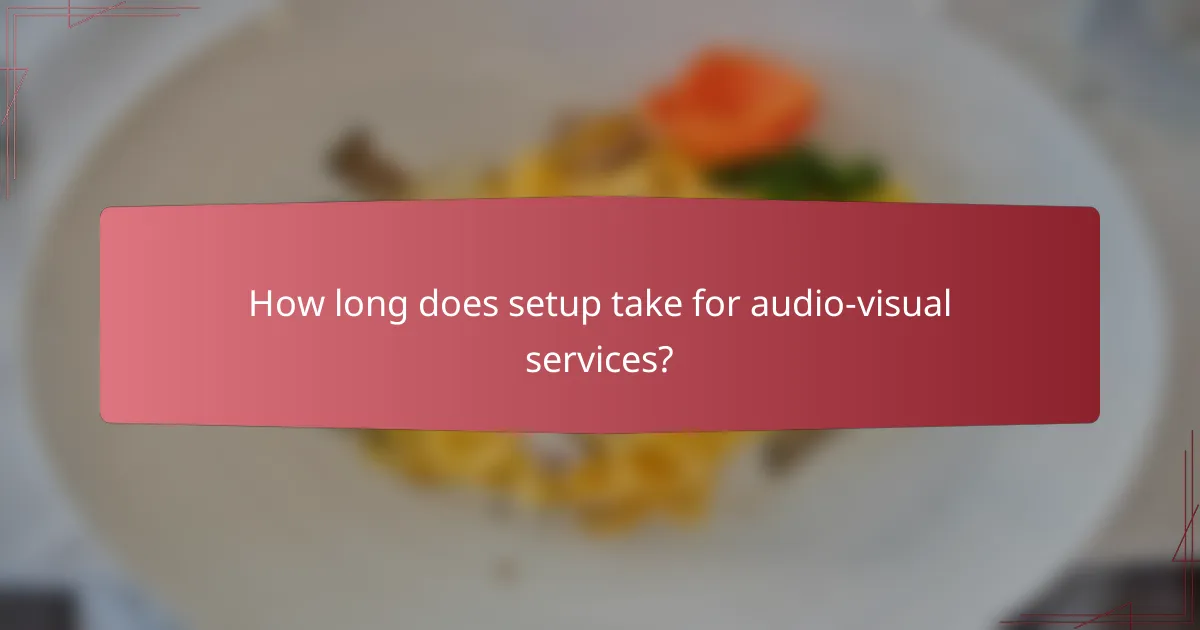
How long does setup take for audio-visual services?
Setup times for audio-visual services can vary widely based on the event’s complexity and the equipment involved. Generally, setup can take anywhere from a few minutes to several hours, depending on the specific requirements and the size of the event.
Typical setup times for events
For small events, such as meetings or presentations, setup usually takes about 30 minutes to 1 hour. Medium-sized events, like corporate functions or weddings, may require 1 to 3 hours for proper setup. Larger events, such as conferences or concerts, can take several hours, often ranging from 3 to 8 hours, particularly if extensive equipment is involved.
Factors affecting setup duration
Several factors can influence how long setup takes for audio-visual services. The complexity of the equipment, the number of devices being used, and the layout of the venue all play significant roles. For example, a simple projector setup will be quicker than a full sound and lighting system for a concert.
Additionally, the availability of technical support can impact setup time. Having a skilled technician on-site can streamline the process, while delays in equipment delivery or technical issues can extend setup duration. It’s advisable to plan for potential delays by allowing extra time in your schedule.

What are the prerequisites for hiring audio-visual services?
To hire audio-visual services effectively, you need to assess your venue requirements and understand the technical specifications necessary for your event. This ensures that the equipment and support you receive will meet your specific needs and expectations.
Venue requirements
When selecting audio-visual services, consider the size and layout of your venue. A larger space may require more powerful sound systems and additional screens to ensure visibility and audibility for all attendees. Additionally, check for access to power sources and internet connectivity, as these are crucial for most AV setups.
It’s also important to evaluate the acoustics of the venue. Spaces with high ceilings or hard surfaces may create echoes, necessitating specialized equipment to manage sound quality. Always communicate these details with your AV provider to tailor the setup accordingly.
Technical specifications
Understanding the technical specifications of the audio-visual equipment is vital for a successful event. Key factors include the resolution of video displays, sound system wattage, and compatibility with your presentation devices. For instance, if you’re using high-definition video, ensure that the projectors or screens support at least 1080p resolution.
Additionally, inquire about the availability of technical support during your event. Having a technician on-site can resolve any issues quickly, minimizing disruptions. It’s advisable to discuss potential challenges and solutions with your AV provider ahead of time to ensure a smooth operation.

How do pricing models work for audio-visual services?
Pricing models for audio-visual services typically fall into two main categories: hourly and flat-rate pricing. Understanding these models helps clients choose the best option based on their project needs and budget constraints.
Hourly vs. flat-rate pricing
Hourly pricing charges clients based on the actual time spent on the project, which can be beneficial for smaller or unpredictable tasks. This model allows flexibility but may lead to higher costs if the project takes longer than anticipated.
Flat-rate pricing, on the other hand, provides a fixed cost for a defined scope of work. This can be advantageous for larger projects, as it offers predictability in budgeting. However, clients should ensure that the scope is clearly defined to avoid unexpected charges for additional services.
Average costs in London
In London, the average cost for audio-visual services can vary significantly based on the type of service and equipment required. Hourly rates typically range from £50 to £150, while flat-rate packages may start around £500 for basic setups.
For larger events or more complex installations, costs can escalate, with comprehensive packages reaching several thousand pounds. Clients should compare quotes from multiple providers to ensure competitive pricing and consider the quality of equipment and support offered.
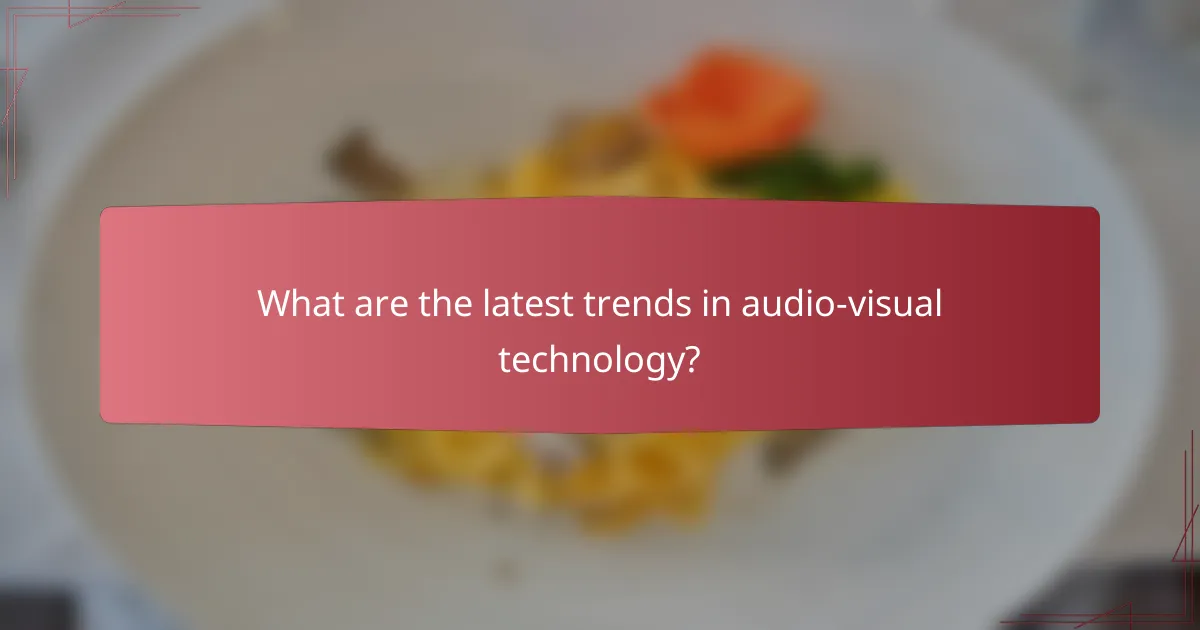
What are the latest trends in audio-visual technology?
The latest trends in audio-visual technology focus on enhanced interactivity, improved resolution, and seamless integration with digital platforms. Innovations such as 4K and 8K displays, immersive audio systems, and AI-driven content management are reshaping how audiences experience events and presentations.
Emerging AV technologies
Emerging audio-visual technologies include virtual reality (VR), augmented reality (AR), and advanced projection systems. VR and AR are increasingly used for immersive experiences in events, allowing participants to engage with content in a more interactive manner. These technologies can transform traditional presentations into dynamic experiences.
Another significant trend is the rise of cloud-based AV solutions, which facilitate remote collaboration and content sharing. This allows teams to work together from different locations, making it easier to manage events and presentations. Additionally, high-definition video conferencing systems are becoming standard, providing clearer visuals and sound quality.
When considering these technologies, it is essential to evaluate the setup time and technical support required. For instance, while cloud solutions may offer flexibility, they often depend on reliable internet connectivity. Planning for potential technical issues and ensuring adequate support can enhance the overall experience.
